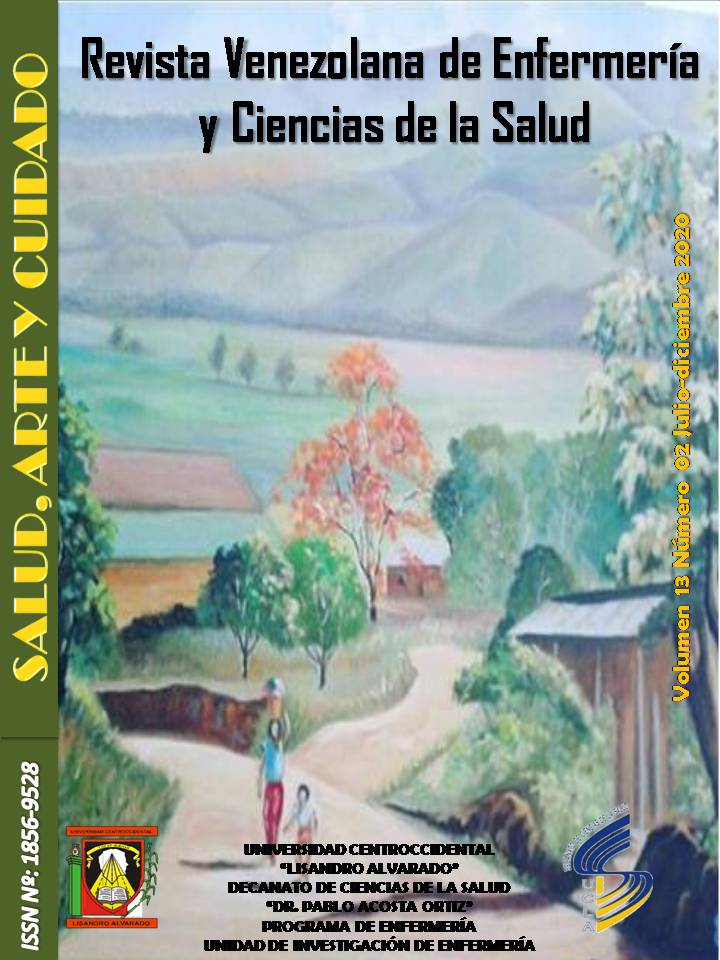Orthostatic hypotension in public health hospital medicine students
Keywords:
orthostatic hypotension, dysautonomia, medical studentsAbstract
Orthostatic hypotension is conceived as a decrease in systolic blood pressure (SBP) by 20 mmHg or in diastolic blood pressure (DBP) by 10 mmHg during standing. It is part of a set of entities called dysautonomies, which are characterized by a variable deficiency of the autonomic nervous system. The present research aimed to determine the characteristics of orthostatic hypotension (HO) in medical students at a Public Health Hospital, located in the Iribarren Municipality, Lara state. This study is framed in the quantitative approach, supported by an exploratory field research, of a descriptive nature, of a non-experimental, transectional design. The study population consisted of 46 medical students, 34 female and 12 male, whose ages range between 22 and 28 years, to whom a structured survey was applied in order to collect information related to their demographic data and functional history. . Then their blood pressure was censored in sitting and standing. The data interpretation was carried out with descriptive statistics and was expressed in frequencies and percentages, representing the results in graphs. Among the findings, it was obtained that 41% of the sample presented symptoms of orthostatic intolerance. In addition, on physical examination, 14% presented HO, of which both the initial and the classic had the same percentages (50%) represented in 83% by women
Downloads
References
Costa Gomes, Teresa Silva. (s.f.). Fisiología del sistema nervioso autónomo (SNA). Barcelona. España. Hospital del Mar Esperanza. Extraída de: http://www.scartd.org/arxius/fisio_sna05.pdf
Saadia, D. Disfunción autonómico. Revista Chilena de Epilepsia. (2003). Recuperado de http://www.revistachilenadeepilepsia.cl/revistas/revista_a4_1_marzo2003/a4_1_tr_disfunsion.pdf
Mar, P. L., y Raj, S. R. Orthostatic hypotension for the cardiologist. Current opinion in cardiology, 33(1), 66–72. (2018). doi:10.1097/HCO.0000000000000467
Militello, CF, Acunzo, RS, Albina, G., Toro, DD, Abelló, MT, Guerrero, RA, Barja, LD, Barrero, CJ, Dubner, SE, Elizari, M., Giniger, AG, Grancelli, HO, González, JL, Labadet, CD, Lerman, J., Moltedo, JM, Oseroff, O., Rabinovich, RF, y Zuloaga, CD Consenso para el Diagnóstico y Tratamiento del Síncope Sociedad Argentina de Cardiología Declaración de consenso para el diagnóstico y manejo del síncope. Sociedad Argentina de Cardiología. (2012).
Palencia, A.- Hipotensión Ortostática en Pacientes Sometidos a Ablación por Radiofrecuencia en el servicio de electrofisiología de CCR- Ascardio Octubre 2017- Agosto 2018 (Universidad Centroccidental Lisandro Alvarado, Barquisimeto, Estado Lara, Venezuela. (2018).
Ali, A., Ali, N. S., Waqas, N., Bhan, C., Iftikhar, W., Sapna, F. Ahmed, A. Management of Orthostatic Hypotension: A Literature Review. Cureus, 10(8), (2018) e3166. doi:10.7759/cureus.3166
Cheng, Y.C., Vyas, A., Hymen, E., Perlmuter, L.C. Gender differences in orthostatic hypotension. The American Journal of the Medical Sciences, 342 (3) 221–225 (2011) Doi: 10.1097/MAJ.0b013e318208752b.
Jones, P. K., Shaw, B. H., & Raj, S. R. Orthostatic hypotension: managing a difficult problem. Expert review of cardiovascular therapy, 13(11), 1263–1276. (2015). doi:10.1586/14779072.2015.1095090
Fedorowski, A., Stavenow, L., Hedblad, B., Berglund, G., Nilsson, P. M., & Melander, O. Orthostatic hypotension predicts all-cause mortality and coronary events in middle-aged individuals (The Malmo Preventive Project). European heart journal, 31(1), 85–91. (2010). doi:10.1093/eurheartj/ehp329
Wijnen, V. K., Harms, M. P., Go-Schön, I. K., Westerhof, B. E., Krediet, C. T., Stewart, J., & Wieling, W. Initial orthostatic hypotension in teenagers and young adults. Clinical autonomic research: official journal of the Clinical Autonomic Research Society, 26(6), 441–449. (2016). Doi: 10.1007/s10286-016-0382-6
Grubb, B.P., Kosinski, D.J., Kanjwal, Y. Orthostatic Hypotension: causes, classification, and treatment. Pacing Clin Electrophysiol. 26 (4) 892-901. (2003) Obtenido de https://www.ncbi.nlm.nih.gov/pubmed/12715851
Published
How to Cite
Issue
Section

This work is licensed under a Creative Commons Attribution-NonCommercial-ShareAlike 4.0 International License.
Derechos del/de autor/es a partir del año de publicación
Esta obra está bajo la licencia:
Creative Commons Reconocimiento-NoComercial-CompartirIgual 4.0 Internacional (CC BY-NC-SA 4.0)
Las opiniones expresadas por los autores no necesariamente reflejan la postura del editor de la publicación ni de la UCLA. Se autoriza la reproducción total o parcial de los textos aquí publicados, siempre y cuando se cite la fuente completa y la dirección electrónica de esta revista. Los autores(as) tienen el derecho de utilizar sus artículos para cualquier propósito siempre y cuando se realice sin fines de lucro. Los autores(as) pueden publicar en internet o cualquier otro medio la versión final aprobada de su trabajo, luego que esta ha sido publicada en esta revista.






